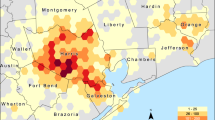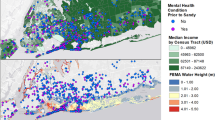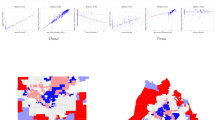Abstract
Background
Hurricane Harvey facilitated exposure to various toxic substances and floodwater throughout the greater Houston metropolitan area. Although disparities exist in this exposure and vulnerable populations can bear a disproportionate impact, no research has integrated disparities in exposure to toxic incidents following Hurricane Harvey.
Objective
The objective of this study was to analyze the relationship between flooding, socioeconomic status (SES), and toxic site incidents.
Methods
Data on toxic site locations, reported releases, and flood water depths during Hurricane Harvey in the greater Houston area were compiled from multiple sources. A multivariable logistic regression was performed to predict the odds of a toxic site release by flooding at the site, SES and racial composition of the census tract.
Results
83 out of 1403 toxic sites (5.9%) had reported releases during Hurricane Harvey. The proportion of toxic sites with reported incidents across increasing SES index quintiles were 8.35, 7.67, 5.14, 4.55, and 0.51, respectively. The odds of an incident were lower in the highest SES quintile areas (ORadj = 0.06, 95% CI: 0.01–0.42) compared to the lowest SES quintile. Flooding was similar at toxic sites with and without incidents, and was distributed similarly and highest at toxic sites located in lower SES quintiles.
Significance
Despite similar flooding across toxic sites during Hurricane Harvey, areas with lower SES were more likely to have a toxic release during the storm, after accounting for number of toxic sites. Improving quality of maintenance, safety protocols, number of storm-resilient facilities may minimize this disproportionate exposure and its subsequent adverse outcomes among socioeconomically vulnerable populations.
This is a preview of subscription content, access via your institution
Access options
Subscribe to this journal
Receive 6 print issues and online access
$259.00 per year
only $43.17 per issue
Buy this article
- Purchase on Springer Link
- Instant access to full article PDF
Prices may be subject to local taxes which are calculated during checkout





Similar content being viewed by others
References
U.S. Energy Information Administration. Hurricane Harvey caused electric system outages and affected wind generation in Texas. 2017. https://www.eia.gov/todayinenergy/detail.php?id=32892.
CBS News. Hurricane Harvey: Teas power outages affect more than quarter-million. 2017. https://www.cbsnews.com/news/hurricane-harvey-texas-power-outages-affect-more-than-255000/. Accessed 6 Aug 2019.
Glenn S. Hurricane Harvey’s environmental impacts: a summary of regional data. Houston Advanced Research Center. 2017. https://harcresearch.maps.arcgis.com/apps/MapSeries/index.html?appid=d6b0a3d762ec46ef8ea676f1008f7028. Accessed 12 Aug 2019.
Associated Press. Hurricane Harvey’s toxic impact deeper than public told. Houston, Texas: Associated Press; 2018. https://apnews.com/article/e0ceae76d5894734b0041210a902218d. Accessed 2 Sept 2019.
Environmental Protection Agency. Status of superfund sites in areas affected by Harvey. 2017. https://www.epa.gov/newsreleases/status-superfund-sites-areas-affected-harvey. Accessed 6 Aug 2019.
Sierra Club. Hurricane Harvey: toxic sites. 2017. https://www.sierraclub.org/environmental-justice/hurricane-harvey-toxic-sites. Accessed 6 Aug 2019.
Kontoyiannis DP, Shah EC, Wurster S, Aitken SL, Graviss L, Raad II, et al. Culture-documented invasive mold infections at MD Anderson Cancer Center in Houston, Texas, Pre–and Post–Hurricane Harvey. In Open forum infectious diseases (Vol. 6, No. 4, p. ofz138). US: Oxford University Press; 2019.
Chow NA, Toda M, Pennington AF, Anassi E, Atmar RL, Cox-Ganser JM, et al. Hurricane-associated mold exposures among patients at risk for invasive mold infections after Hurricane Harvey—Houston, Texas, 2017. Morbidity Mortal Wkly Rep. 2019;68:469.
Burger J, Gochfeld M. Conceptual environmental justice model for evaluating chemical pathways of exposure in low-income, minority, Native American, and other unique exposure populations. Am J Public Health. 2011;101:S64–73.
Chakraborty J, Collins TW, Grineski SE. Exploring the environmental justice implications of Hurricane Harvey flooding in Greater Houston, Texas. Am J Public Health. 2019;109:244–50.
Flores AB, Castor A, Grineski SE, Collins TW, Mullen C. Petrochemical releases disproportionately affected socially vulnerable populations along the Texas Gulf Coast after Hurricane Harvey. Popul Environ. 2021;42:279–301.
Walker G. Beyond distribution and proximity: exploring the multiple spatialities of environmental justice. Antipode. 2009;41:614–36.
Mohai P, Lantz PM, Morenoff J, House JS, Mero RP. Racial and socioeconomic disparities in residential proximity to polluting industrial facilities: evidence from the Americans’ Changing Lives Study. Am J Public Health. 2009;99:S649–56.
Alexander AC, Ali J, McDevitt-Murphy ME, Forde DR, Stockton M, Read M, et al. Racial differences in posttraumatic stress disorder vulnerability following Hurricane Katrina among a sample of adult cigarette smokers from New Orleans. J Racial Ethn Health Disparities. 2017;4:94–103.
Rhodes J, Chan C, Paxson C, Rouse CE, Waters M, Fussell E. The impact of Hurricane Katrina on the mental and physical health of low-income parents in New Orleans. Am J Orthopsychiatry. 2010;80:237.
Fussell E, Lowe SR. The impact of housing displacement on the mental health of low-income parents after Hurricane Katrina. Soc Sci Med. 2014;113:137–44.
Galea S, Brewin CR, Gruber M, Jones RT, King DW, King LA, et al. Exposure to hurricane-related stressors and mental illness after Hurricane Katrina. Arch Gen Psychiatry. 2007;64:1427–34.
Burton A. Crisis not over for hurricane victims. Environ Health Perspect. 2006;114:A462.
Rath B, Young EA, Harris A, Perrin K, Bronfin DR, Ratard R, et al. Adverse respiratory symptoms and environmental exposures among children and adolescents following Hurricane Katrina. Public Health Rep. 2011;126:853–60.
Lowe SR, Willis M, Rhodes JE. Health problems among low-income parents in the aftermath of Hurricane Katrina. Health Psychol. 2014;33:774.
Chew GL, Wilson J, Rabito FA, Grimsley F, Iqbal S, Reponen T, et al. Mold and endotoxin levels in the aftermath of Hurricane Katrina: a pilot project of homes in New Orleans undergoing renovation. Environ Health Perspect. 2006;114:1883–9.
Institute of Medicine. Environmental Public Health Impacts of Disasters: Hurricane Katrina: Workshop Summary. Washington, DC: The National Academies Press; 2007. https://doi.org/10.17226/11840.
Chakraborty J, Maantay JA, Brender JD. Disproportionate proximity to environmental health hazards: methods, models, and measurement. Am J Public Health. 2011;101:S27–36.
Collins TW, Grineski SE, Chakraborty J, Flores AB. Environmental injustice and Hurricane Harvey: a household-level study of socially disparate flood exposures in Greater Houston, Texas, USA. Environ Res. 2019;179:108772.
Chakraborty J, Grineski SE, Collins TW. Hurricane Harvey and people with disabilities: disproportionate exposure to flooding in Houston, Texas. Soc Sci Med. 2019;226:176–81.
Collins TW, Grineski SE, Chakraborty J, Montgomery MC, Hernandez M. Downscaling environmental justice analysis: determinants of household-level hazardous air pollutant exposure in Greater Houston. Ann Assoc Am Geographers. 2015;105:684–703.
Karaye I, Stone KW, Casillas GA, Newman G, Horney JA. A spatial analysis of possible environmental exposures in recreational areas impacted by Hurricane Harvey Flooding, Harris County, Texas. Environ Manag. 2019;64:381–90.
Horney JA, Casillas GA, Baker E, Stone KW, Kirsch KR, Camargo K, et al. Comparing residential contamination in a Houston environmental justice neighborhood before and after Hurricane Harvey. PloS One. 2018;13:e0192660.
Federal Emergency Management Administration (FEMA) (2018). FEMA - Harvey Flood Depths Grid, HydroShare, https://doi.org/10.4211/hs.165e2c3e335d40949dbf501c97827837. Accessed 6 Aug 2019.
Yost K, Perkins C, Cohen R, Morris C, Wright W. Socioeconomic status and breast cancer incidence in California for different race/ethnic groups. Cancer Causes Control. 2001;12:703–11.
Yu M, Tatalovich Z, Gibson JT, Cronin KA. Using a composite index of socioeconomic status to investigate health disparities while protecting the confidentiality of cancer registry data. Cancer Causes Control. 2014;25:81–92.
Ari P. Preparing for the next storm: learning from the man-made environmental disasters that followed Hurricane Harvey. 2018. https://www.environmentalintegrity.org/wp-content/uploads/2018/08/Hurricane-Harvey-Report-Final.pdf. Accessed 2 Sept 2019.
Nixon R. Slow violence and the environmentalism of the poor. Cambridge, Massachussets: Harvard University Press; 2011.
Blum J. Failures of floating-roof oil tanks during Harvey rase concerns. 2017. https://www.houstonchronicle.com/business/energy/article/Failures-of-floating-roof-tanks-during-Harvey-12269513.php. Accessed 2 Sept 2019.
Misuri A, Moreno VC, Quddus N, Cozzani V. Lessons learnt from the impact of hurricane Harvey on the chemical and process industry. Reliab Eng Syst Saf. 2019;190:106521.
Nicole W. Wristbands for Research: Using Wearable Sensors to Collect Exposure Data after Hurricane Harvey. Environ Health Perspect. 2018;126:042001.
Author information
Authors and Affiliations
Corresponding author
Ethics declarations
Conflict of interest
The authors declare no competing interests.
Additional information
Publisher’s note Springer Nature remains neutral with regard to jurisdictional claims in published maps and institutional affiliations.
Rights and permissions
About this article
Cite this article
Lieberman-Cribbin, W., Liu, B., Sheffield, P. et al. Socioeconomic disparities in incidents at toxic sites during Hurricane Harvey. J Expo Sci Environ Epidemiol 31, 454–460 (2021). https://doi.org/10.1038/s41370-021-00324-6
Received:
Revised:
Accepted:
Published:
Issue Date:
DOI: https://doi.org/10.1038/s41370-021-00324-6
Keywords
This article is cited by
-
Methods in Public Health Environmental Justice Research: a Scoping Review from 2018 to 2021
Current Environmental Health Reports (2023)



